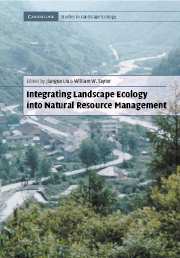Book contents
- Frontmatter
- Contents
- List of contributors
- Foreword
- Preface
- Acknowledgments
- PART I Introduction and concepts
- PART II Landscape structure and multi-scale management
- 2 Integrating landscape structure and scale into natural resource management
- 3 Focal patch landscape studies for wildlife management: Optimizing sampling effort across scales
- 4 Managing for small-patch patterns in human-dominated landscapes: Cultural factors and Corn Belt agriculture
- 5 A landscape approach to managing the biota of streams
- 6 Linking ecological and social scales for natural resource management
- PART III Landscape function and cross-boundary management
- PART IV Landscape change and adaptive management
- PART V Landscape integrity and integrated management
- PART VI Syntheses and perspectives
- Index
- Plate Section
2 - Integrating landscape structure and scale into natural resource management
Published online by Cambridge University Press: 14 January 2010
- Frontmatter
- Contents
- List of contributors
- Foreword
- Preface
- Acknowledgments
- PART I Introduction and concepts
- PART II Landscape structure and multi-scale management
- 2 Integrating landscape structure and scale into natural resource management
- 3 Focal patch landscape studies for wildlife management: Optimizing sampling effort across scales
- 4 Managing for small-patch patterns in human-dominated landscapes: Cultural factors and Corn Belt agriculture
- 5 A landscape approach to managing the biota of streams
- 6 Linking ecological and social scales for natural resource management
- PART III Landscape function and cross-boundary management
- PART IV Landscape change and adaptive management
- PART V Landscape integrity and integrated management
- PART VI Syntheses and perspectives
- Index
- Plate Section
Summary
Introduction
Resource managers face an almost impossible task. They are confronted with multiple goals that are promoted by interest groups championing specific and often conflicting agendas. Forceful arguments are made that management should focus on maximizing yield, preserving ecosystem integrity, fostering sustainability, enhancing biodiversity, protecting populations of endangered species, or preserving natural values (Daily and Walker, 2000). Moreover, the principles of ecology that guided management for so long – equilibrium, stability, spatial homogeneity, density-dependence, carrying capacity, orderly succession, and the like – have fallen on hard times. Predictability and certainty have given way to uncertainty, and the new paradigms of ecology emphasize spatial and temporal variability, thresholds, uncertainties, and contingencies (Wiens, 1984; Westoby et al., 1989; Botkin, 1990; Pickett et al., 1992; Pickett and Ostfeld, 1995; Stafford Smith, 1996). It is also apparent that these dynamics and effects play out differently at different scales of time and space (Wiens, 1989; Levin, 1992; Peterson and Parker, 1998). Robust predictions are hard to come by.
Faced with all this uncertainty, what is a resource manager to do? What help can science provide? Our thesis is that, because it focuses explicitly on the spatial relationships and dynamics of landscapes, landscape ecology can provide a particularly useful framework for effective management of natural resources. After all, most problems in resource management involve land and water use. Management of wildlife populations, for example, is often accomplished by managing “habitat” (Verner et al., 1986; Morrison et al., 1998; Rolstad, 1999), and many of the conflicts over grazing or timber harvesting (e.g., Graetz, 1994; West, 1996; Hunter, 1999) revolve around different perspectives on land use and its consequences (Meyer and Turner, 1994; Dale, 1997).
- Type
- Chapter
- Information
- Publisher: Cambridge University PressPrint publication year: 2002
- 26
- Cited by



